Monogramming and embroidery, often used interchangeably, are distinct yet closely related techniques in textile embellishment.
While both involve stitching designs onto fabric, the key difference lies in their focus and scope. Monogramming entails arranging initials or symbols into an artistic design, emphasizing personalization.
On the other hand, embroidery encompasses a broader range of decorative stitching, including intricate patterns, motifs, and images beyond letters.
Understanding the nuances between monogramming and embroidery is essential for those seeking to add a personalized touch to textiles, whether through stylized initials or elaborate embroidered designs.
This exploration unveils the unique qualities and applications that define these timeless textile art forms.
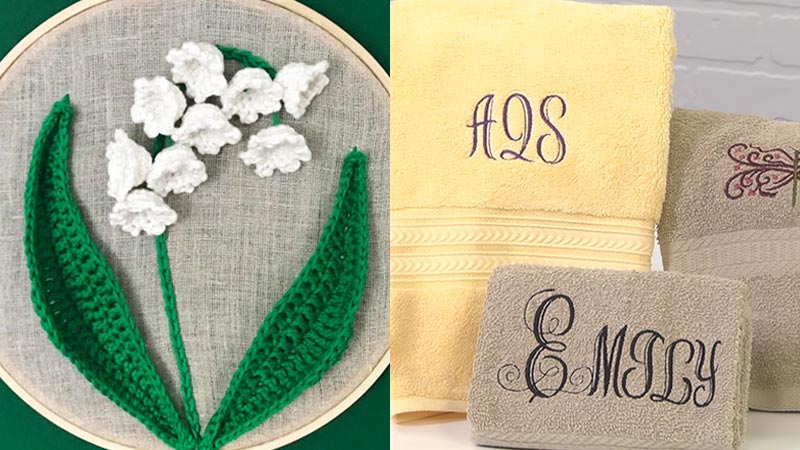
What Is Monogramming in Sewing?
Monogramming in sewing is a decorative technique that involves stitching one’s initials or other symbols onto fabric items.
Typically done with a specialized font or script, monogramming adds a personalized and elegant touch to textiles such as clothing, linens, and accessories.
This customization often employs embroidery stitches to create stylized arrangements of letters, contributing to a unique and individualized appearance.
Monogramming is a widespread practice in sewing, providing a means for personal expression and enhancing the aesthetic appeal of various fabric-based items.
What Is Embroidery in Sewing?
Embroidery in sewing is a decorative art form that involves stitching intricate designs, patterns, or motifs onto fabric using a needle and thread.
This versatile technique can be applied by hand or with the assistance of embroidery machines.
Embroidery allows for a wide range of creative expression, utilizing various stitches, colors, and textures to enhance the visual appeal of fabric items.
It extends beyond monogramming, encompassing various designs, from floral patterns to intricate details.
Popular in both fashion and home decor, embroidery adds a personalized and artistic touch to garments, accessories, and other fabric-based creations.
Difference Between Monogram and Embroidery
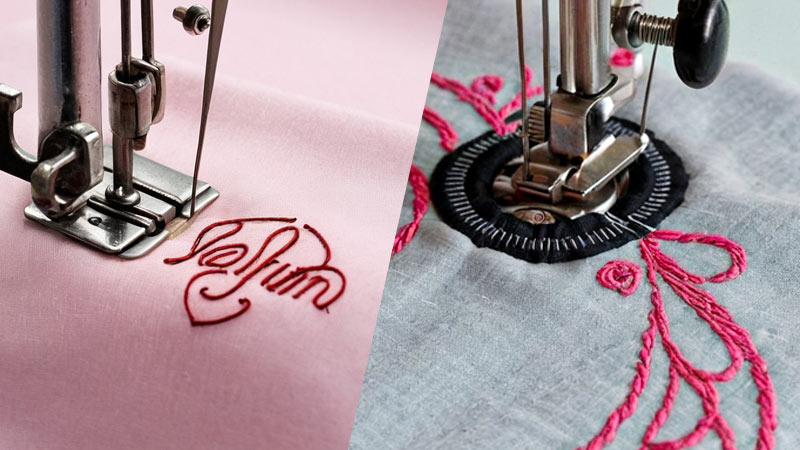
Monogramming and embroidery are distinct techniques within the realm of textile customization, each offering unique ways to enhance the aesthetic appeal of fabric items.
While these terms are often used interchangeably, they represent different approaches to embellishing textiles.
Let’s explore the key differences between monogramming and embroidery:
| Criteria | Monogramming | Embroidery |
| Definition | Decorative arrangement of initials or symbols into a stylized design. | Artistic stitching of intricate designs, patterns, or motifs onto fabric using a needle and thread. |
| Technique | Primarily, it focuses on arranging letters or symbols for a personalized touch. | Utilizes a variety of stitches such as satin, chain, and cross-stitch, allowing for detailed and complex designs. |
| Scope | Encompasses various designs beyond letters, including floral motifs, landscapes, logos, and geometric patterns. | It can be done by hand or machine, focusing on creating cohesive letter designs. |
| Application | It can be done by hand using embroidery hoops and needles or with embroidery machines that automate the stitching process. | Applied to enhance the aesthetic appeal of clothing, home decor (e.g., pillows, tablecloths), accessories, and artistic projects. |
| Tools | Typically, it involves using embroidery thread or floss in a limited color palette. | Can be done by hand or machine, focusing on creating cohesive letter designs. |
| Purpose | Adds a touch of individuality and sophistication to personalized items. | Enhances fabric items with intricate and decorative elements, allowing for artistic expression and customization of a broader range of items. |
| Materials | Typically involves using embroidery thread or floss in a limited color palette. | It is generally considered more accessible, making it suitable for beginners. |
| Popularity | Widely popular for monogrammed gifts, wedding items, and personalized accessories. | Prevalent in fashion design, home decor, and traditional crafts, with a rich history dating back centuries. |
| Skill Level | Generally considered more accessible, making it suitable for beginners. | Varied skill levels, ranging from simple stitches for beginners to intricate techniques requiring advanced skills for detailed designs. |
Common Uses of Monogramming
Monogramming is a versatile and popular method of personalization, adding a distinctive touch to various items.
Its charm lies in the decorative arrangement of initials or symbols, creating a unique design that often carries personal or sentimental significance.
Here are the common uses of monogramming:
Apparel
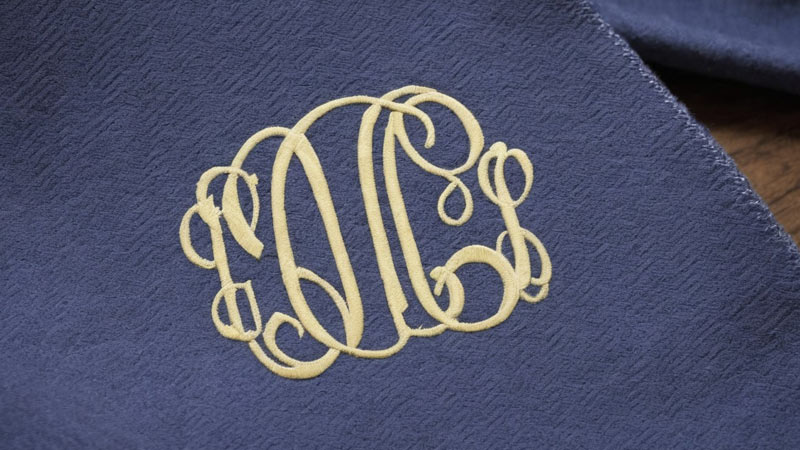
When applied to apparel, monogramming becomes a bespoke expression of personal style. The carefully crafted intertwining of initials on shirts, jackets, and dresses transforms these garments into unique, wearable art.
Accessories such as scarves, hats, gloves, and handbags adorned with monograms enhance individual style and serve as timeless, personalized fashion statements.
Home Goods
In the realm of home goods, monogramming adds a touch of refinement and sophistication. Bed linens become more than just functional pieces; they become personalized sanctuaries with monogrammed initials.
Similarly, monogrammed napkins, placemats, and tablecloths elevate the dining experience, turning everyday moments into occasions for celebration.
Gift Items
Monogramming takes gift-giving to a new level by infusing a sense of thoughtfulness and personal connection.
Wedding gifts featuring monogrammed towels or glassware become cherished mementos of the special day.
Celebratory events like birthdays and anniversaries are enriched by monogrammed items, reflecting a deep consideration for the recipient.
Stationery and Paper Goods
The world of stationery and paper goods becomes an avenue for artistic expression through monogramming.
Notepads, cards, and envelopes adorned with carefully designed initials transform simple writing tools into elegant statements.
The monogrammed book covers and photo albums add a personalized touch to cherished memories, turning them into tangible, uniquely crafted keepsakes.
Corporate Branding
Monogramming plays a pivotal role in corporate branding, offering a distinctive way to reinforce organizational identity.
Company merchandise, from gifts to uniforms, becomes a canvas for the organization’s emblem or initials.
This fosters a sense of unity among employees and establishes a professional and cohesive visual identity for the brand.
Children’s Items
Monogramming brings an element of playfulness and practicality to children’s belongings.
Beyond the functional aspect of easy identification, monogrammed clothing, backpacks, and lunchboxes become markers of individuality for young ones. It introduces them to personalization in a fun and visually appealing way.
Personal Accessories
Everyday personal accessories become an extension of individuality through monogramming. When personalized with initials or symbols, wallets, purses, keychains, phone cases, and laptop sleeves turn into unique expressions of personal style.
These items serve functional purposes and become cherished possessions that tell a story.
Event Decor
Monogramming extends its influence to event decor, creating a harmonious and personalized atmosphere.
Banners, decorations, and favors featuring monograms weave a cohesive theme throughout the event, transforming ordinary spaces into visually stunning and memorable environments.
Whether for birthdays, baby showers, or holidays, monogrammed decor adds an extra layer of sophistication to the celebration.
Common Uses of Embroidery
Embroidery, with its intricate stitching and artistic designs, finds various applications across various domains.
Its versatility makes it a popular choice for adding a touch of elegance and creativity to different items.
Here are the common uses of embroidery:
Apparel
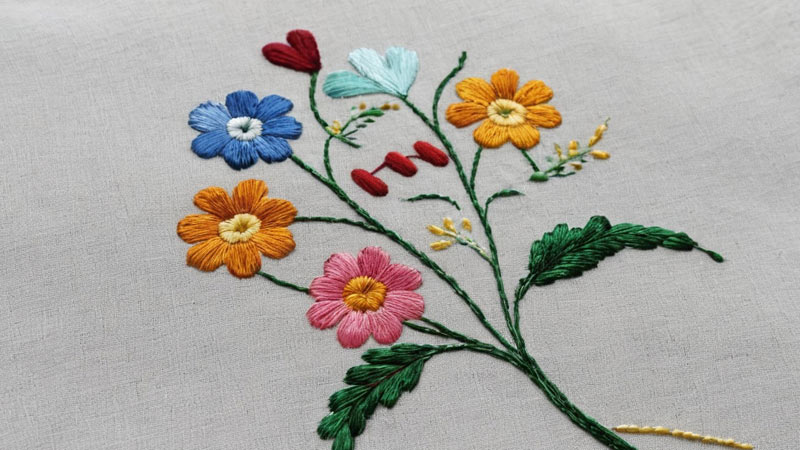
Embroidery, as an art form on apparel, goes beyond mere decoration. It transforms clothing into personalized statements, with intricate designs, logos, or patterns meticulously stitched onto shirts, blouses, dresses, and denim.
The skillful application of embroidery on accessories such as hats, scarves, gloves, and shoes elevates them from functional items to unique expressions of individual style and creativity.
Home Decor
Within home decor, embroidery becomes a mark of refined taste. Bedspreads adorned with intricate stitches create an inviting and luxurious atmosphere in bedrooms.
Decorative pillows, wall hangings, and table runners featuring carefully embroidered details turn ordinary living spaces into artistry showcases, adding warmth and personality to the home.
Fashion Accessories
Fashion accessories undergo a remarkable transformation with the addition of embroidery. Handbags and purses become not just functional items but canvases for artistic expression.
Belts and hats featuring elaborate embroidery transcend their utilitarian roles, becoming focal points that reflect a wearer’s unique sense of style and flair.
Personal Items
Embroidery lends a distinctive touch to personal items, making them more than mundane necessities.
Towels and bathrobes bearing embroidered initials or decorative patterns become intimate expressions of personal identity.
Blankets, especially when adorned with carefully crafted embroidery, evolve into cherished keepsakes, blending utility with sentimental value.
Corporate Branding
In the corporate world, embroidery is a visual representation of identity and professionalism. Uniforms adorned with meticulously embroidered logos contribute to a sense of cohesion and brand recognition.
Promotional items, such as caps, T-shirts, and bags featuring embroidered company logos, not only serve marketing purposes but also enhance the organization’s overall image.
Special Occasions
Embroidery plays a significant role in infusing elegance into memorable occasions. Bridal gowns adorned with exquisite embroidery become timeless pieces of art.
Embroidered handkerchiefs or accessories serve as meaningful gifts, encapsulating the essence of celebrations like weddings, birthdays, and anniversaries.
Art and Crafts
Embroidery transcends mere practicality in the realm of art and crafts. It becomes a central technique in needlepoint and cross-stitch crafts, enabling artists to create intricate and detailed designs on fabric.
Embroidery hoops, functioning as creative frames, allow artists to showcase their skills and imaginative expressions on a smaller scale.
Cultural and Ethnic Textiles
Across diverse cultures, embroidery is woven into the fabric of traditional garments. Intricate patterns and cultural symbols, meticulously embroidered, tell stories of heritage and identity.
In the broader context of textile art, embroidery becomes a form of expression that blends craftsmanship with cultural significance, contributing to the richness of cultural textiles worldwide.
Can You Monogram With an Embroidery Machine?
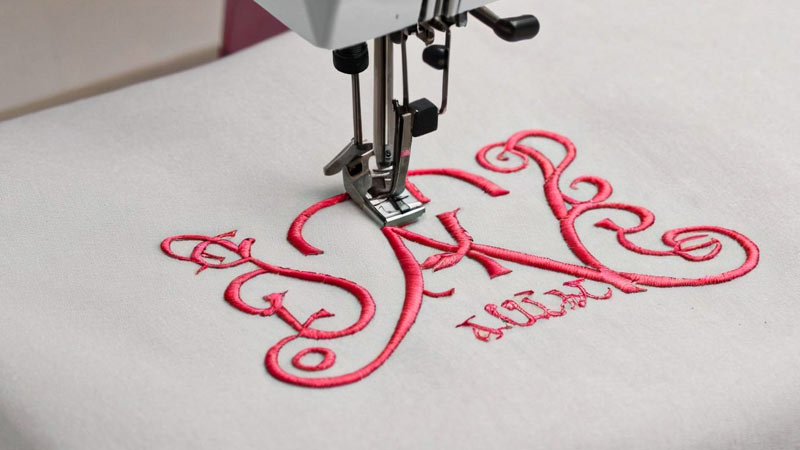
Yes, monogramming with an embroidery machine is a popular and efficient method that combines monogram design’s artistry with machine embroidery’s precision and speed.
An embroidery machine can replicate intricate monograms, allowing for consistent and professional results.
Here’s how monogramming is accomplished using an embroidery machine:
Design Selection
When choosing a monogram design, consider the occasion, personal preferences, and the intended recipient’s style.
Many modern embroidery machines offer a vast array of built-in monogram fonts and designs, ranging from classic to contemporary.
Additionally, some machines provide the flexibility to import custom designs, allowing for endless possibilities in personalization.
Hooping the Fabric
Proper hooping is crucial for achieving precise and flawless monogramming. Ensure the fabric is taut and appropriately aligned within the embroidery hoop.
Stabilizers or interfacing is essential to prevent the fabric from puckering or stretching during embroidery. This step lays the foundation for a well-executed and aesthetically pleasing monogram.
Thread and Needle Selection
Choosing the right thread colors is an artistic decision that can significantly impact the final appearance of the monogram. Experiment with different color combinations that complement the fabric and design.
Equally important is selecting appropriate needles based on the fabric type. Using the right needle ensures smooth stitching and prevents damage to delicate materials.
Machine Setup
Loading the chosen monogram design onto the embroidery machine requires attention to detail. Adjust settings such as size, orientation, and density to match the specific requirements of your project.
Following the machine’s instructions for setup is crucial to achieving accurate and consistent results. This step lays the groundwork for a seamless monogramming process.
Testing
Before committing to the final fabric, run a test on a scrap piece to ensure that the monogram placement, size, and thread tension are optimal.
This precautionary step helps identify any adjustments needed to achieve the desired outcome. Testing is a valuable practice that minimizes the risk of errors on the actual project, saving time and materials.
Embroidery Process
Initiating the embroidery process involves starting the machine, which automatically follows the programmed design. The machine’s precise movements and controlled stitching bring the monogram to life on the fabric.
Each pass of the embroidery hoop adds intricate details, resulting in a professionally executed monogram with consistent stitch quality.
Finishing Touches
Careful attention to the finishing touches is essential upon the embroidery completion. Removing the fabric from the hoop requires precision to avoid any unintended distortion.
Trim excess threads neatly and address any stabilizer residue. Depending on the project, additional steps such as washing might be necessary to remove water-soluble stabilizers, ensuring the monogram looks pristine.
Personalization and Customization
The true beauty of using embroidery machines lies in the realm of personalization and customization. Experiment with various fonts, sizes, and thread colors to tailor the monogram to individual preferences.
Some advanced machines even allow for the integration of additional design elements, such as flourishes or decorative motifs, providing endless opportunities for creative expression.
FAQs
Is Monogram and Embroidery the Same Thing?
No, monogramming and embroidery are different; monogramming is a specific form that focuses on arranging initials or symbols in an artistic design.
Can an embroidered design also be a monogram?
Yes, an embroidered design can include a monogram, but not all are monograms.
To Recap
While monogramming and embroidery share the art of stitching designs onto fabric, they diverge in focus and scope.
Monogramming is a specialized subset of embroidery, honing in on arranging initials or symbols in unique, personalized designs.
In contrast, embroidery encompasses a broader spectrum, incorporating intricate patterns, motifs, and images beyond letters.
The distinction is crucial for those seeking to enhance textiles through personalized monograms or diverse embroidered designs.
Recognizing the unique qualities of each technique empowers individuals to choose the most fitting method for adding a touch of sophistication and personalization to their fabric-based creations, preserving the timeless charm of textile embellishment.
Leave a Reply